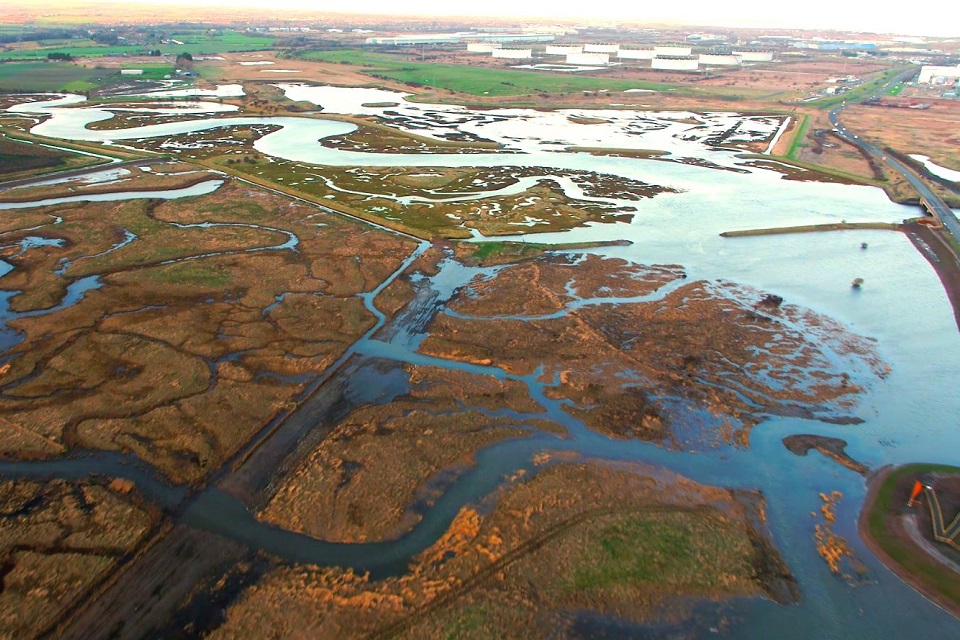Environment Agency

A ground-breaking set of projects to help the River Tees Estuary adapt to climate change, restore valuable habitat for internationally important wildlife and reconnect the rivers tributaries has officially launched.
With funding of more than 30million, the Tees Tidelands programme aims to realign flood defences, restore mudflat and saltmarsh habitat, and remove tidal barriers so migratory fish can return to rivers where they have been absent for hundreds of years.
In total, Tees Tidelands aims to create over 50 hectares of mudflats, saltmarsh and other valuable estuarine habitats, as well as reducing flood risk for homes and businesses, now and into the future.
The Tees Estuary has been heavily modified by human hand in the last 200 years as it transformed into a hub of industrial activity. While vital for jobs and the economy, this led to the loss of 90% of the intertidal habitat that once existed.
The Environment Agency, together with partners including Stockton-on-Tees Borough Council, the Royal Society for the Protection of Birds (RSPB), the Canal & River Trust, Teesside Environmental Trust, Tees Rivers Trust, Natural England and Tees Valley Wildlife Trust aim to redress the balance between nature and industry in a way that adapts to climate change and secures the future economic prosperity of Teesside.
The ambitious Tees Tidelands programme features schemes across Teesside at sites near Greatham, Port Clarence, Portrack, along the banks of the River Tees and in rivers such as Lustrum Beck, Ormesby Beck and Billingham Beck.

Enhancing the environment
Phil Marshall, Senior Advisor for the Environment Agency in the North East, said:
Tees Tidelands will help to safeguard the future economic prosperity of Teesside in a way that enhances the environment, using nature-based solutions to deliver long-term flood risk management.
Allowing the estuary to realign with its natural tidal cycle will create the correct conditions for wildlife to thrive. It will also reconnect the communities of Teesside with their estuary, a relationship gradually lost over the last 200 years.
The official launch of the project is a big moment, and we are grateful for the collective support of our partners as we work to bring the vision of Tees Tidelands to life and deliver these long-term benefits for people and nature.
All of the projects in the Tees Tidelands programme will use inspiring nature-based solutions to reduce flood risk, increase climate change resilience and help nature recover while protecting and enhancing the most important conservation sites within the estuary.
Examples of work taking place include:
- Restoring tidal habitats such as saltmarshes and mudflats, reducing flood risk and creating a home for wildlife.
- The re-alignment and improvement of existing flood defences.
- Opening the tributaries of the River Tees to tidal influence through the removal of barriers to allow for a more naturally functioning river system and fish migration.
- The restoration of Billingham Beck and Lustrum Beck at Stockton-on-Tees.

Vital work increases resilience
Councillor Bob Cook, Leader of Stockton-on-Tees Borough Council, said:
These projects are a great way of protecting the environment and another strong example of our ongoing work alongside our partner organisations.
This vital work will reduce risk and increase resilience to flooding, but importantly it also supports the Councils Environmental Sustainability and Carbon Reduction Strategy which includes the restoration of natural habitats many of which have been lost due to historical human intervention.
Once complete they will further protect residents homes and businesses as well as attract wildlife to thrive and the community to enjoy.
Areas of the estuary were lost right up to the 1970s to create land to build industrial complexes. Several flood defences built to protect those complexes are now old, in poor condition and difficult to maintain.
Historical construction used waste material, including slag boulders, from the local iron and steel industry. These defences are not considered to be fit for the purpose of managing long term flood risk given their current state of repair and predicted sea level rise with climate change.
The habitats and species remaining in the estuary are now internationally recognised and protected by the highest level of conservation designations.
Vicky Ward, Natural Englands Tees Estuary Recovering Nature Project Manager, said:
The Tees Tidelands programme is an incredible contribution to the Tees Estuary and will provide significant reduction to flood risks for local communities and industries.
Habitat restoration work taking place throughout the programme will also strengthen natures recovery across the estuary. Natural England is excited to be working closely with the Environment Agency and wider partner organisations to coordinate and deliver best outcomes for nature over the long-term.
Tees Tidelands stands alongside partner-led projects such as Tees Rivers Trusts work to grow and reintroduce seagrass and oysters into coastal and estuary habitats, and the Canal & River Trust which is working to enhance fish passage at the Tees Barrage.
Looking to the future Tees Tidelands partners are also keen to work with Natural Englands Tees Estuary Recovering Nature (T.E.R.N.) national nature recovery project, and wider partners, to build on the current work to capture the future aspirations of partners for bigger, better, more joined up nature recovery at the lands
